Data Masking Market Size
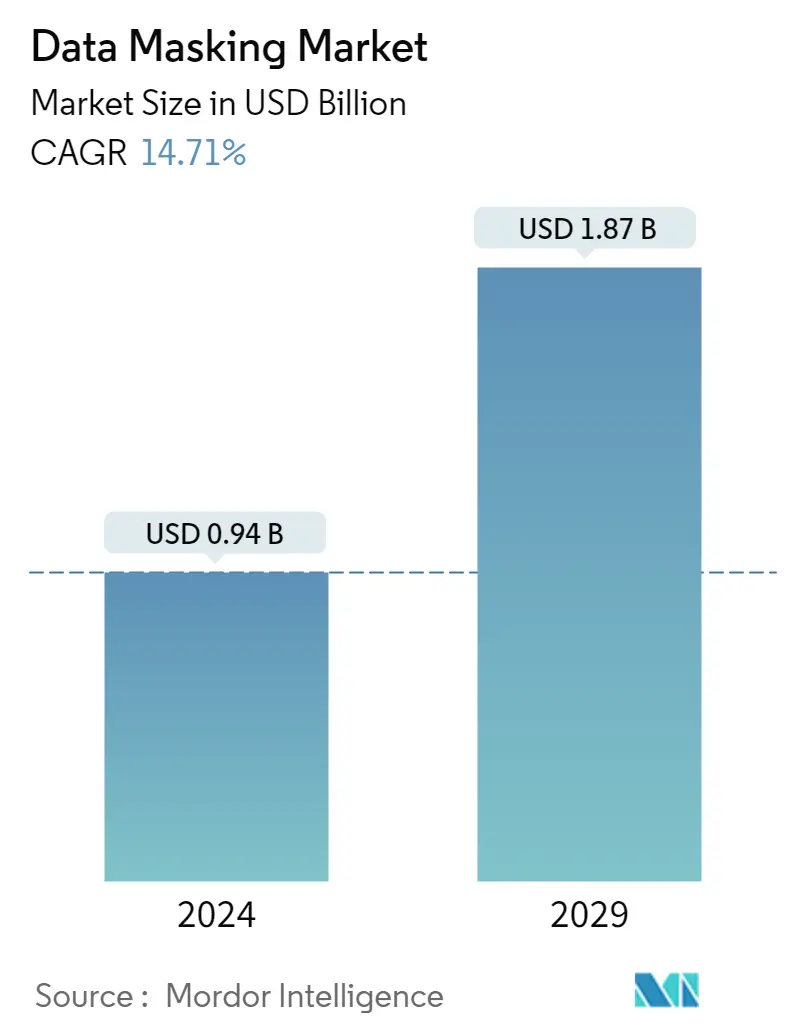
| Study Period | 2019 - 2029 |
| Market Size (2024) | USD 0.94 Billion |
| Market Size (2029) | USD 1.87 Billion |
| CAGR (2024 - 2029) | 14.71 % |
| Fastest Growing Market | Asia-Pacific |
| Largest Market | North America |
Major Players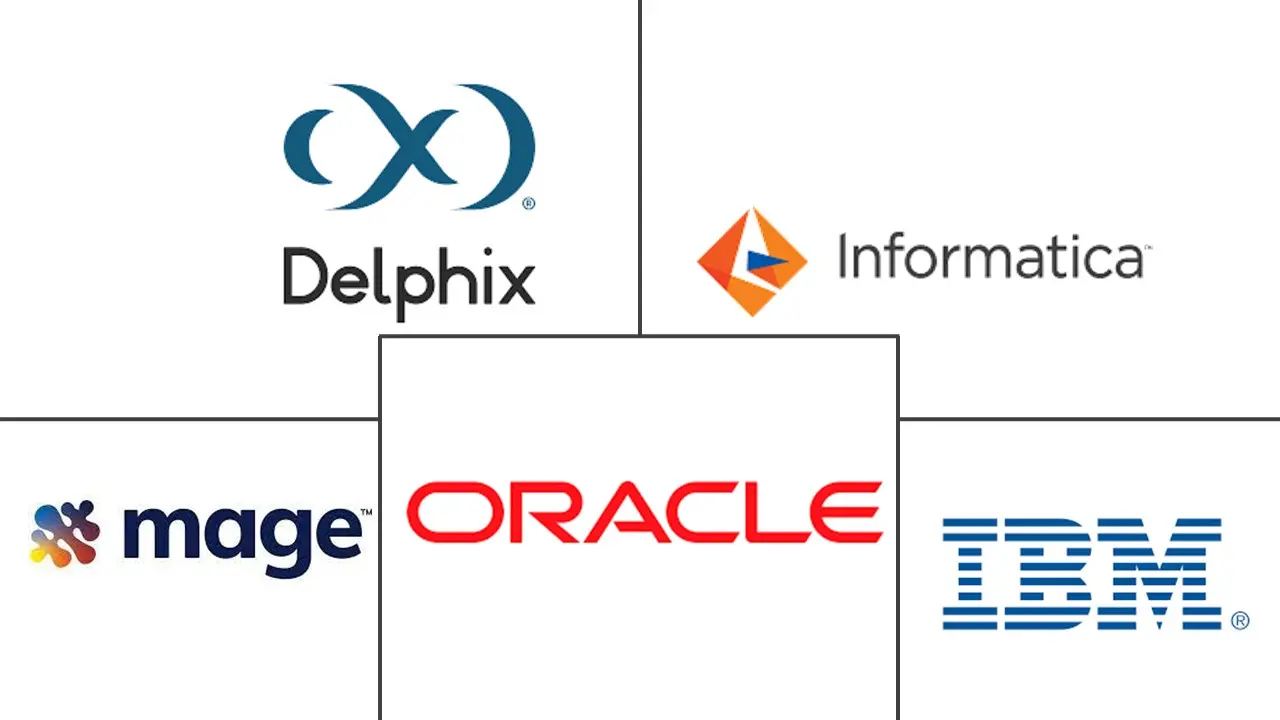
*Disclaimer: Major Players sorted in no particular order |
Data Masking Market Analysis
The Data Masking Market size is estimated at USD 0.94 billion in 2024, and is expected to reach USD 1.87 billion by 2029, growing at a CAGR of 14.71% during the forecast period (2024-2029).
In this information age, cyber security is essential. With the growth of breaches and malware attacks, data masking is making its way into the data-driven industry.
- Data masking is an intelligent technology that provides real-time data masking of production data. Data masking technology allows for analyzing large amounts of data without disrupting routine company processes. In other words, data masking technology produces a fake but realistic version of organizational data to safeguard sensitive organizational information.
- The increasing need for decreasing the risk of data breaching is fueling the dynamic data masking market growth, which is expected to execute the fastest growth rate over the forecast period. Besides, active data masking helps to protect sensitive and personal data while supporting outsourcing, offshoring, and cloud-based initiatives.
- Furthermore, considering the significant demand among enterprises for securing their financial data, the requirement for data masking and better security solutions is projected to play a vital role in the market's growth. Data-driven finance has mandated that every organization have an accounting department to store and maintain financial data that includes large monetary transactions that, if leaked, could result in issues with the company's reputation and monetary losses in the market, as well as issues with regulatory directives such as PCI DSS, HIPAA, and other enforced laws. This is the most crucial reason driving the growth of the data masking market in this business function.
- However, a lack of skilled workers and technological competence in poor and developing nations and a lack of standardization may limit market expansion. Increasing complexity in data integration and synchronization may also slow industry development. A solid IT infrastructure in developing nations would also hinder market expansion.
- Due to the COVID-19 outbreak, countries have implemented preventive measures. With schools being closed and communities being asked to stay at home, multiple organizations found a way to enable employees to work from their homes. This resulted in a rise in data breaches and fuels the growth of the data masking market. Due to rapid digitization, the market is also growing after the pandemic.
Data Masking Market Trends
This section covers the major market trends shaping the Data Masking Market according to our research experts:
The BFSI Industry to Witness a Significant Growth
- The BFSI industry is one of the critical infrastructure segments that face multiple data breaches and privacy issues, owing to the massive customer base that the sector serves and the financial information at stake. Cybercriminals are optimizing various diabolical cyberattacks to immobilize the financial sector as a highly lucrative operation model with phenomenal returns and the added upside of relatively low risk and detectability. These attacks' threat landscape ranges from Trojans, ATMs, ransomware, mobile banking malware, data breaches, institutional invasion, data thefts, fiscal breaches, etc.
- Banks, insurance firms, credit bureaus, and lenders rely on data to understand and build deeper relationships with their consumers and determine whether the market fluctuates and maintains stable growth. However, this valuable data is being sought by both cybercriminals and insiders, and data privacy regulators are growing more demanding in their compliance requirements. Data masking tools help to safely design innovative, personalized experiences for their customers.
- In April 2021, the Reserve Bank of India (RBI) proposed cybersecurity norms for payment service providers (PSPs) following a series of data breaches faced by operators, including Mobikwik and payment aggregator JusPay. While the standards for fintech-driven payment services providers would be like cyber hygiene norms issued for banks and non-banking finance companies, the RBI is quite clear that firms will have to do more than observe the minimum standards to ensure digital safety transactions gain further traction.
- In 2022, financial firms worldwide were impacted by innovative new ransomware tactics that maximized ROI for the threat actors. While financial firms represent a small percentage of victims directly targeted by ransomware attacks, they can and have been impacted by attacks on third parties, who are prime targets. Such threats are poised to increase the usage of cybersecurity solutions in the BFSI sector.
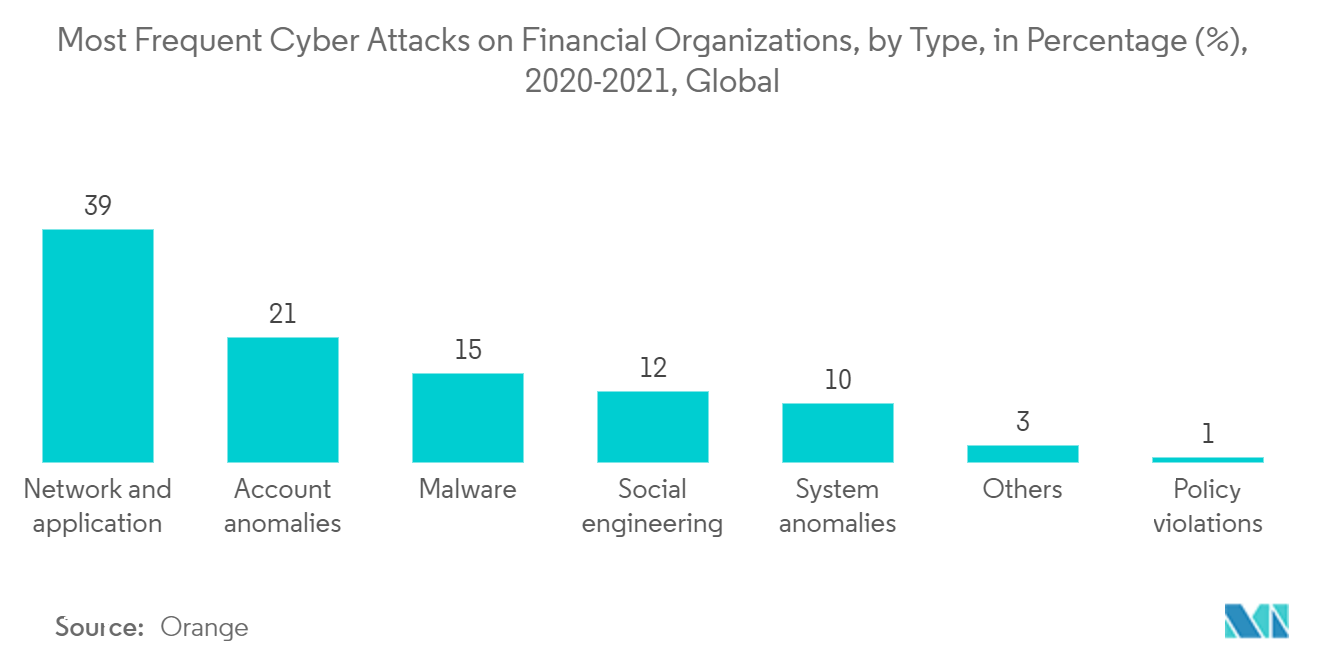
Asia Pacific is Expected to be the Fastest Growing Market
- The Asia Pacific is expected to witness a higher growth rate than other regions because developing countries, such as India and China, are the world's two biggest economies. Automotive industries in the region increased over the past few years. The growth in these industries was propelled by a vast population shift and an increase in disposable incomes, which resulted in higher demand.
- Currently, these two countries are growing faster, and many developmental activities are being done here to set up new manufacturing industries and product launches. All these activities contribute to big data. Lots of data are being stored daily, which is very crucial. The rapid digitization among developing countries, such as India, China, and Singapore, has produced the bulk of unstructured data.
- Furthermore, owing to technological advancements, there is an increase in the number of connected devices in China. It is the largest global Internet of Things (IoT) market. Furthermore, 5G and 5 G-enabled devices will exponentially increase the devices' interconnectivity. As a result, it increases connected devices, directly augmenting the market's need for security products. The websites are thereby prone to be manipulated and impersonated by third parties, and sensitive user data communicated with the website can be intercepted more easily by foreign intelligence agencies.
- On the other hand, the increasing adoption of public cloud computing is leading to more enterprises re-allocating their business systems to cloud platforms. Issues concerning data security, tenant isolation, access control, etc., have gradually become a focal point of these enterprises.
- Data privacy has become a hot topic in China since the Chinese government has actively publicized data privacy rules and regulations in recent years. The Cybersecurity Law (CSL) (2017), the Data Security Law (DSL) (2021), and the Personal Information Protection Law (PIPL) have all been published and are currently in effect. For instance, in June 2022, China published the final version of the Certification Specification for Cross-Border Processing of Personal Information, which could provide companies with guidance on how to have their cross-border data transfer certified as one of the legal routes for business operators to transfer personal information outside China.
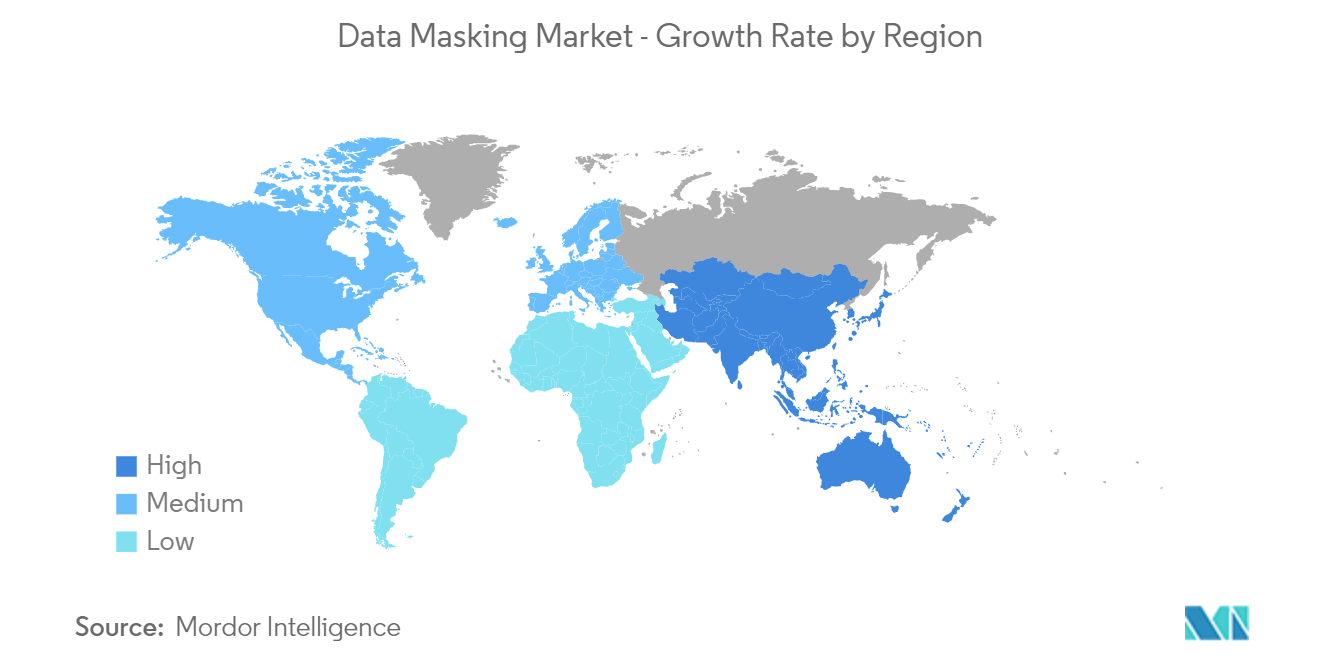
Data Masking Industry Overview
The data masking market is highly fragmented due to many global players in this industry. This market is highly competitive. Some key competitive players in the data masking market are IBM Corporation, Oracle Corporation, Informatica LLC, Delphix Corp., and Mentis, Inc. (Mage). The major players in the data masking market follow the strategy of strategic partnership, mergers or acquisitions of various local players, and product innovation to gain a competitive edge in the market.
- June 2022 - IBM Corporation announced its plans to acquire Randori, a prominent attack surface management (ASM) and offensive cybersecurity provider. Randori helps clients continuously identify assets visible to attackers, both on-premise and in the cloud, and prioritize exposures that pose the most significant risk. The acquisition aims to advance IBM's Hybrid Cloud strategy further and strengthen its AI-powered cybersecurity products and services portfolio.
Data Masking Market Leaders
-
IBM Corporation
-
Oracle Corporation
-
Informatica LLC
-
Delphix Corp.
-
Mentis, Inc. (Mage)
*Disclaimer: Major Players sorted in no particular order
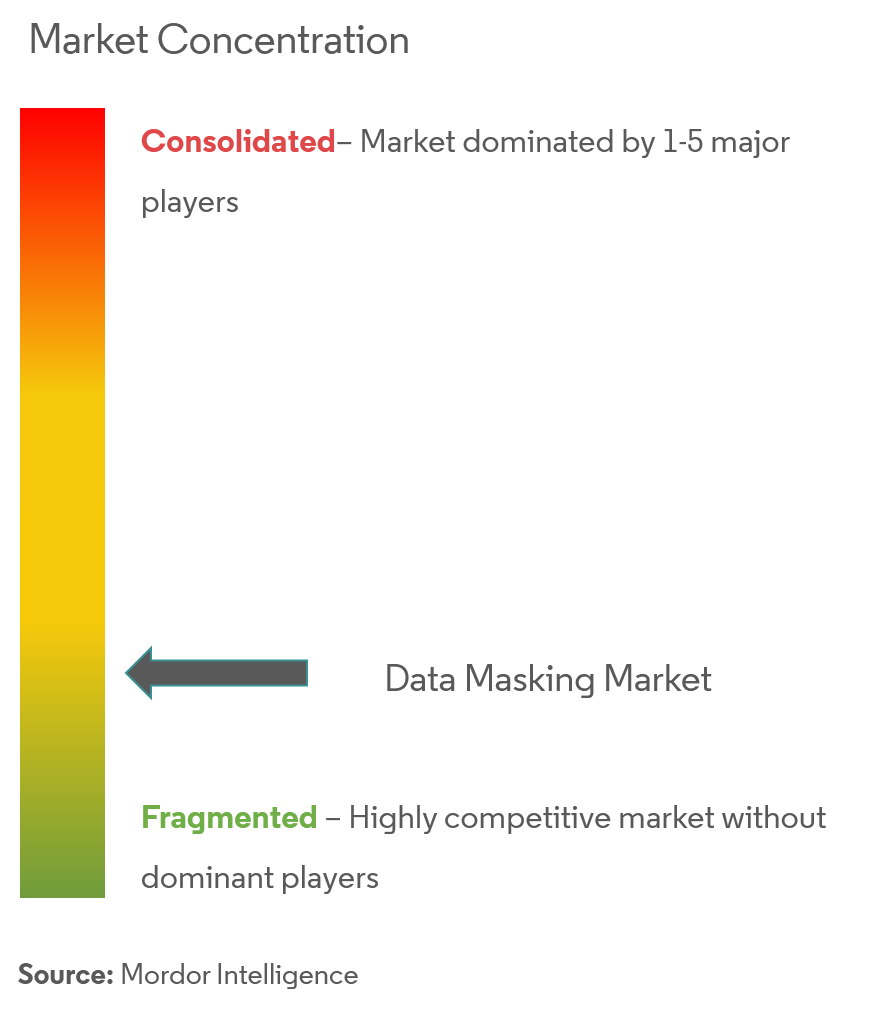
Data Masking Market News
- August 2022 - IBM released a new update, IBM Cloud Pak Data V4.5.x, of Advanced data masking, extended the capability of data protection and location rules by protecting the data with advanced de-identification techniques. The techniques preserve the data's format and integrity. Because of the high data utility, data users such as data scientists, business analysts, and application developers may generate high-quality insights from protected data.
- April 2022 - Mage signed a technology partnership agreement with Imperva to provide a data masking alternative to Imperva's Data Security Fabric (DSF) built-in capabilities for de-identifying sensitive data.
Data Masking Market Report - Table of Contents
1. INTRODUCTION
- 1.1 Study Assumptions and Market Definition
- 1.2 Scope of the Study
2. RESEARCH METHODOLOGY
3. EXECUTIVE SUMMARY
4. MARKET DYNAMICS
- 4.1 Market Overview
- 4.2 Introduction to Market Drivers and Restraints
-
4.3 Market Drivers
- 4.3.1 Increase of Organizational Data Volumes
-
4.4 Market Restraints
- 4.4.1 Technological Complexities Associated with Data Masking Challenge the Market Growth
-
4.5 Industry Attractiveness - Porter's Five Forces Analysis
- 4.5.1 Threat of New Entrants
- 4.5.2 Bargaining Power of Suppliers
- 4.5.3 Bargaining Power of Consumers
- 4.5.4 Threat of Substitutes
- 4.5.5 Intensity of Competitive Rivalry
- 4.6 Impact of COVID-19 on the Market
5. TECHNOLOGY SNAPSHOT
6. MARKET SEGMENTATION
-
6.1 By Type
- 6.1.1 Static
- 6.1.2 Dynamic
-
6.2 By Deployment
- 6.2.1 Cloud
- 6.2.2 On-premise
-
6.3 By End-user Industry
- 6.3.1 BFSI
- 6.3.2 Healthcare
- 6.3.3 IT and Telecom
- 6.3.4 Retail
- 6.3.5 Government and Defense
- 6.3.6 Manufacturing
- 6.3.7 Media and Entertainment
- 6.3.8 Other End-user Industries
-
6.4 By Geography
- 6.4.1 North America
- 6.4.1.1 United States
- 6.4.1.2 Canada
- 6.4.2 Europe
- 6.4.2.1 United Kingdom
- 6.4.2.2 Germany
- 6.4.2.3 Rest of Europe
- 6.4.3 Asia Pacific
- 6.4.3.1 China
- 6.4.3.2 India
- 6.4.3.3 Rest of Asia Pacific
- 6.4.4 Latin America
- 6.4.5 Middle East and Africa
7. COMPETITIVE LANDSCAPE
-
7.1 Company Profiles
- 7.1.1 IBM Corporation
- 7.1.2 Oracle Corporation
- 7.1.3 Informatica LLC
- 7.1.4 Delphix Corp.
- 7.1.5 Mentis Inc. (Mage)
- 7.1.6 Innovative Routines International Inc.
- 7.1.7 Solix Technologies Inc.
- 7.1.8 K2view Ltd
- 7.1.9 Red Gate Software Ltd
- 7.1.10 Broadcom Inc.
- *List Not Exhaustive
8. INVESTMENT ANALYSIS
9. MARKET OPPORTUNITIES AND FUTURE TRENDS
** Subject To AvailablityData Masking Industry Segmentation
Data masking methodically changes private data elements such as trade secrets and personally-identifying information (PII) into realistic but fictitious values. Masking allows data recipients to use "production-like" information while complying with privacy protection regulations.
The scope of the study focuses on the market analysis of data masking solutions globally. Market sizing encompasses the revenue generated through proven data masking techniques globally sold by various market players. The study also tracks the key market parameters, underlying growth influencers, and major vendors operating in the industry, which supports the market estimations and growth rates over the forecast period. The study further analyzes the overall impact of COVID-19 on the ecosystem. The report's scope encompasses market sizing and forecast for segmentation by type, deployment, end-user industry, and geography. The market sizes and forecasts are provided in terms of value (USD million) for all the above segments.
| By Type | Static | |
| Dynamic | ||
| By Deployment | Cloud | |
| On-premise | ||
| By End-user Industry | BFSI | |
| Healthcare | ||
| IT and Telecom | ||
| Retail | ||
| Government and Defense | ||
| Manufacturing | ||
| Media and Entertainment | ||
| Other End-user Industries | ||
| By Geography | North America | United States |
| Canada | ||
| By Geography | Europe | United Kingdom |
| Germany | ||
| Rest of Europe | ||
| By Geography | Asia Pacific | China |
| India | ||
| Rest of Asia Pacific | ||
| By Geography | Latin America | |
| Middle East and Africa |
Data Masking Market Research FAQs
How big is the Data Masking Market?
The Data Masking Market size is expected to reach USD 0.94 billion in 2024 and grow at a CAGR of 14.71% to reach USD 1.87 billion by 2029.
What is the current Data Masking Market size?
In 2024, the Data Masking Market size is expected to reach USD 0.94 billion.
Who are the key players in Data Masking Market?
IBM Corporation, Oracle Corporation, Informatica LLC, Delphix Corp. and Mentis, Inc. (Mage) are the major companies operating in the Data Masking Market.
Which is the fastest growing region in Data Masking Market?
Asia-Pacific is estimated to grow at the highest CAGR over the forecast period (2024-2029).
Which region has the biggest share in Data Masking Market?
In 2024, the North America accounts for the largest market share in Data Masking Market.
What years does this Data Masking Market cover, and what was the market size in 2023?
In 2023, the Data Masking Market size was estimated at USD 0.82 billion. The report covers the Data Masking Market historical market size for years: 2019, 2020, 2021, 2022 and 2023. The report also forecasts the Data Masking Market size for years: 2024, 2025, 2026, 2027, 2028 and 2029.
Data Masking Industry Report
Statistics for the 2024 Data Masking market share, size and revenue growth rate, created by Mordor Intelligence™ Industry Reports. Data Masking analysis includes a market forecast outlook to 2029 and historical overview. Get a sample of this industry analysis as a free report PDF download.



